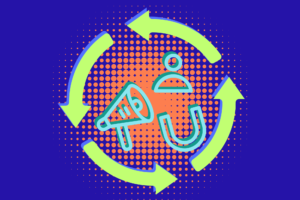Table of Contents
Last Updated on August 10, 2021 by admin
BackBay Communications reports that 96% of the largest fintech companies consistently create thought leadership content. Fintechs, like other organizations, understand the importance of content marketing to drive business results. As content marketing efforts increase, the marketplace has been flooded with content.
All the noise has made it harder than ever to stand apart from competitors and grab the attention of an audience. Producing high-quality content is one of the best ways to differentiate, but it also means you need to re-evaluate your content production process to fill gaps, fix problems, and improve in any way possible.
To help, we’ve put together a guide for writing a killer fintech blog post. While we’re honing in on blog content specifically, many of these tips can be applied to other content pieces as well.
1. Make a Splash With Your Headline
I would argue that your headline is the most important element of your blog post because it’s the first thing people see. A lackluster headline can lead people to abandon your article before they even get started. Alternatively, an inspired headline can draw people in while also informing them about what they’ll get out of reading your post.
That’s right: not only should your headline whet your reader’s appetite, but it should also present them with the value of what you’ll be covering in the post. They need to know what’s in it for them. There are plenty of different ways to do this in your blog posts headlines, depending on the type of topic you’re covering. For example:
- How-to: helps people achieve an outcome
- Listicles: Provides a number of ways to do something
- Mistake avoidance: Let’s someone know things they should avoid
- Secrets: Provides exclusive or “secret” information
- Testimonial: Provides another’s experience in achieving an outcome
- Reasons: Offers rationale for doing or not doing something
2. Hook Your Reader
Even after grabbing your reader’s attention with your headline, you need to hold onto it. People have the attention span of a goldfish and they need to be reminded over and over again why they’re reading.
This is the job of your first paragraph. It should be constructed in a way that grabs — and holds — the reader’s attention. There are a few ways to do this:
- Ask them to use their imagination: This trick engages your reader by getting them involved and asking them to take action. Asking them to recall something or paint a picture with their mind are two ways you might use this tip.
- Ask a question: Similarly to using their imagination, asking your reader a question gets them mentally involved. If I ask you a question, isn’t it your natural impulse to answer it? See.
- Use second person: Saying you/your/yours is a great way to build rapport with your reader and make the post seem more conversational.
- Tell a story: People love stories. Starting your article with an anecdote is a wonderful way to grab the reader’s attention long enough that they continue reading. Bonus points if you can wrap value into the story as well.
- Educate your reader: Starting your article with relevant, interesting facts can get your reader engaged upfront.
3. Build an Enticing Story
While you may use an anecdote as a gripping opener, your entire blog post should also build an intriguing narrative with a punchy storyline. Storytelling has become a major buzzword in content marketing, but very few do it well.
The stakes are higher for fintechs who often deal with dryer subject matter that can be hard to weave into a compelling story. But it’s not impossible. The key is to make sure you’re including the tried and true elements of storytelling throughout your blog post. The funny thing about storytelling is that there is an endless number of elements that people think you should have. Don’t believe me? Try googling “5 elements of storytelling.” Now try googling “3 elements of storytelling.” Now try “10 elements of storytelling.” Everyone has a different idea of what makes a great story.
For simplicity’s sake, we’re going to focus on five elements: setting, plot, characters, conflict, and theme. From a journalistic standpoint: where, when, what, who, how, why. You want to make sure you’re letting people know the timeframe and location of your story for relevance. You’ll lay out relatable characters that your audience can connect with. Those characters will experience some sort of conflict (a challenge or pain point that your audience can relate to) that will get resolved. Finally, you’ll want to make sure that the theme of your story is woven throughout.
Once you have this framework in place, you can sprinkle in other ingredients that make your story engaging and that keep your audience reading until the end. Sprinkle in suspense to keep your audience anticipating what will happen next. This could be a teaser like “at the end of this blog post, you’ll…”.
Be sure to keep things relatable. This may mean adding a touch of vulnerability — something that makes you more authentic and authoritative in the eyes of your audience. Think fintech and vulnerability (not the cybersecurity kind) don’t mix? Think again: a survey conducted by Google in partnership with CEB’s Marketing Leadership Council found that Most B2C brands have emotional connections with somewhere between 10% and 40% of customers. Seven out of nine of the B2B brands had emotional connections with more than 50% of their customers.
4. Provide Value
Don’t forget the reason your audience is reading your fintech blog post: to get something of value. Whether you’re providing the lay of the land in a trends piece or offering helpful tips in a listicle, don’t forget to add in value.
It can be helpful to do this in a way that accommodates those that may be skimming your article (hint: that is a bigger number than you think it is). People want to get what they need quickly, so use bullet points where you can. Add in examples that people can quickly jump to. Break up dense text into more readable sections.
5. Close the Loop
Once you’ve created a killer fintech blog post chock full of the elements we’ve outlined above, don’t forget to close the loop. People expect things to come back full circle. We love it when loose ends get tied up nicely with a big pink bow.
If you’ve done a good job building a meaningful story, the end should seem apparent and happen naturally. Be sure that your conflict has a resolution — that your readers know how the story ends. When finished, read through your entire post from start to finish. Does it end in a way that feels satisfying to you?
6. Ask for Action
Your fintech blog post isn’t complete yet. Once you have wrapped up your story, think about the best call to action for your readers. Sure, you may want them to share or comment, but you may also be teasing an ebook, white paper, or report. Another option is to tease related stories below each blog post. Make it as easy as possible for people to do the thing you’re asking of them by making CTAs and links big, bold, and easy-to-click (especially on mobile devices).
Writing a killer fintech blog post isn’t rocket science, but it is important. Break out of the blog post mold and get adventurous in how you compose your articles. While there are frameworks that work, don’t be afraid to run your own experiments and test new ways to engage your audience. What matters is that you include all the elements of a good story and entice your readers to come back for more.



